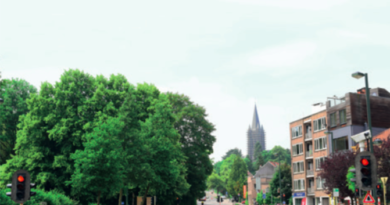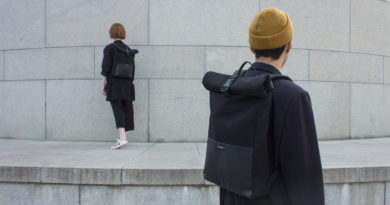Discovering Brussels’ Old Taverns
The old stock exchange building, la Bourse, stands quiet overlooking a crowded Anspach boulevard, streams of people walking by, delivery boys on their bicycles zigzagging their way through. The building’s high neoclassical facade is illuminated in alternating colors of blue, orange, sometimes pink. Two large posters hang from the porticos announcing an upcoming exhibition on Pompeii, the Immortal City. Across the street, a digital clock shows the time: seven fifty eight at night; seven degrees Celsius. A group of about twenty people has gathered at the foot of la Bourse’s steps to explore a selection of taverns through the heart of old town Brussels in a tour organized by Bruxelles-Bavard. Sacha, our guide, begins the tour by talking about the history of the Anspach boulevard.
“Before the boulevard existed, the Senne river used to run through here,” he says. “But it became very polluted, a source of infection and disease in the nineteenth century, until the decision was taken to cover it. Much of the urbanization that followed took its inspiration from Paris. There were letters exchanged between Jules Anspach, mayor of Brussels, and Baron Haussmann.”
He then turns his torso and mentions that la Bourse’s first stone was brought from France in 1869, but shortly after the Franco-Prussian war started and the rest of the stones had to be shipped from England. “Auguste Rodin was involved in the construction,” he says. “You’ll see his work on the external decorations on the left side of the building.”
The first tavern we stop to look at is Maison Cirio, of the same origin as the famous tomato canning company Cirio, created by Piamonte-born Francesco Cirio. The restaurant dates from 1886 but some of its decoration is of somewhat later manufacture. The chairs’ and tables’ legs have curved, plant-like shapes, emblematic of the Art Nouveau style. The walls are covered by a a thin layer of leather, which has been worked in high-relief. The area near the Bourse, explains Sacha, used to house several theaters. People came to many of these bars and restaurants by the dozens.
“But during the depression, of course, things changed,” he says. “People use to drink the famous half-and-half, which was a mix of white wine and sparkling wine. It was their way of wishful thinking, their way of imagining they were still drinking champagne.”
The next stop is La Becasse or The Woodcock, on Rue de Tabora. The tavern dates from 1877 and took its name from the fact that the owners, the Steppe family, had taken a liking to hunting woodcocks in the forest. On the second floor, the group finds a seat while Sacha pours everyone a glass of Lambic, a sweet beer typical of Brussels and surrounding area, brewed only by spontaneous fermentation. Then he mentions Hette Kaise, the word in Bruxellois or Brusselaar dialect to describe the typical cheese of Brussels.
“It’s very salty,” he explains. “You have to mix it with Platte Kaise, or white cheese, then you get Potte Kaise, to which you absolutely have to add shallots. Oh, that’s just delicious. To lick one’s fingers.”
After La Becasse, we walk a few meters north on Rue de Tabora. At the corner of Rue du Marché aux Herbes, a trio of street musicians plays blues. Some people have gathered around them. Couples observe hand in hand, steam coming out of their mouths; children chew on fritjes, push in two, sometimes three before swallowing, their noses smeared with mayonnaise. The smell of waffles and roasted chestnuts wafts in the air.
At the Impasse St. Nicholas, a narrow dead-end alley, we enter Au Bon Mieux Temps.A few meters away from a stained glass window with the image of Sainte Gudule and Saint Michel, patrons of Brussels, Sacha mentions the theories behind the word Estaminet.
“Some people believe it comes from the Dutch expression, ‘sta mijnheer,’ which means ‘stand up, sir,’ and used to be said whenever you raised your glass to cheer. But nobody really knows. Now it is used to describe a traditional tavern. A place where you can get together with friends and have a beer.”
He also tells the story of how, on this same alley, in the offices of Spirou Magazine, the famous character Gaston came to life. “It was here, in one of the small office rooms of Spirou, where André Franquin created Gaston back in 1957. He looks young, Gaston, but he’s sixty years old.”
Our final walk takes us through Rue des Bouchers, where Egyptian-French singer-songwriter Georges Moustaki once lived, and it was the direct inspiration to his book, La Petite Rue de Bouchers. On Rue du Finistere, we stop to admire the art-deco style of Taverne Esperance. The furniture’s upholstery is green with geometrical patterns and the chairs have ninety-degree angles, its armrests high and at the same level as the backrest.
At the cafe of the Metropole Hotel, the group slouches back on the chairs, take off jackets and beanie hats, while we wait for a set of Jambe-de-Bois beers. “Don’t forget to look at the reception and the lobby over there,” says Sacha, with the same energy and passion as two hours before. “The decoration is gorgeous. You just don’t know where to look at.”



